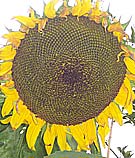JERUSALEM ARTICHOKE
VEGETABLE PAGES

GARDEN TIP
Slugs and snails do not like travelling over gritty surfaces and roofing felt is perfect to stop them reaching your plants.
The smell of the bitumen and the rough surface is too much for them.
JERUSALEM ARTICHOKES -VARIETIES TO GROW
Fuseau
Red Fuseau
New White
Stampede
SOCIETIES
JERUSALEM ARTICHOKES

Jerusalem Artichokes, Helianthus tuberosus,
are a tuberous-rooted vegetable and not related in any way to the
Globe Artichoke, but are related to the sunflower.
They are not easy to prepare for the table as the tubers of almost all the varieties are very knobbly - but they do make very tasty chips.
Jerusalem artichokes will grow up to 3 meters (7ft) tall and for that reason they can be used as a hedge or wind break.
They need well drained soil. They prefer a warm and dry position and will crop well on ground where other vegetables have failed.
To produce large Jerusalem artichoke tubers, dig in some well rotted compost or manure. One bucketful to the square meter/ yard.
When the time comes for planting , apply some fertilizer (meat and bone meal) and some potash.
PLANTING JERUSALEM ARTICHOKES
In March or early April prepare the bed by hoeing out a furrow 15cm(6in) deep. Use a tightly stretched string line.
Spread well-rotted manure or garden compost evenly along the bottom.
Try to plant tubers about the size of a chicken egg and use the ones that are as smooth as possible.
The less knobbly the tuber ,the less knobbly the crop will be.
Plant the tubers 30cm (1ft) apart in the furrow and cover over with soil leaving a ridge about 5cm 2(in) high on the top - then sprinkle an organic fertilizer .
TENDING JERUSALEM ARTICHOKES
When the plants are about 30cm (1ft) high draw the soil up to the plants with the hoe.
Do this every two weeks until the soil is earthed up 15cm (6in) or more.
The artichokes will grow very tall so if they are exposed to the wind they will need some support. You can use stake and wire for this - this is so they will not blow over and expose the tubers.
At the end of October the tubers under ground will have been made and the tops can be cut down to within 60cm (2ft) from soil level. Chop up the tops and compost them.
HARVESTING JERUSALEM ARTICHOKES
The tubers are very hardy and could be left in the ground until needed in winter. But lifting them from frozen soil is not easy, so dig them up carefully at the end of November.
Put them in a pile and cover them with 15cm (6in) of straw and then 15cm (6in) of soil. Or in boxes of sand or peat in a well ventilated shed.
Dig up all the tubers however small or the jerusalem artichoke may become a weed the following year.